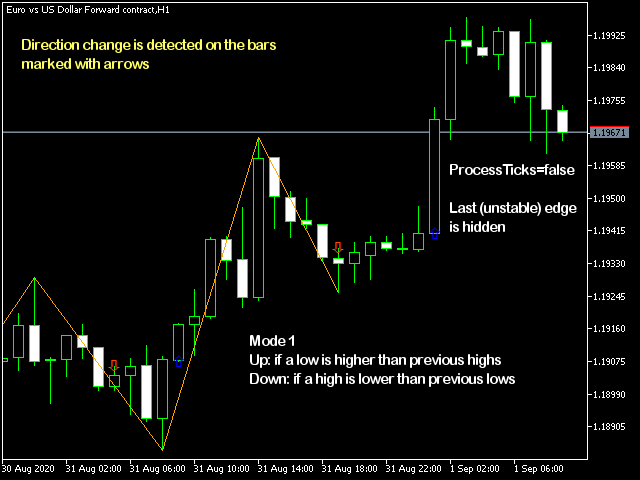- The edges go up until they meet a bar whose maximum (high) is below the highest minimum (low), and the edges go down until they meet a bar whose minimum (low) is above the lowest maximum (high);
- Gann reversals: the edge goes up while high and low rise at each subsequent bar; the edge goes down while high and low fall at each subsequent bar; the inner bars (with lower high and higher low) and the outer bars (with higher high and lower low) do not affect the change of the edge;
- Weiss waves: bars with an increasing closing price form an edge up; bars with a decreasing closing price form an edge down;
- Changing the direction by correcting the price by a specified % or using an adaptive algorithm;
Parameters
- Mode – one of the modes: High below Low/Low above High, Gann swing, Close vs Close (Weis wave), Retracement;
- ProcessTicks – the option to calculate on each tick is disabled by default (false); with this setting, the last unfinished edge is not displayed; if the option is set to true, the last unfinished edge is displayed, but it can change its position in accordance with price changes;
- RetracementPercent – the size of the rollback as a percentage of the price ( % ), which will change the direction of the zigzag (only for the Retracement and Close vs Close modes); 0 by default means a special auto-adaptive adjustment (see below);
[spoiler title=”Read More…”]
- Mode – one of the modes: High below Low/Low above High, Gann swing, Close vs Close (Weis wave), Retracement;
- ProcessTicks – the option to calculate on each tick is disabled by default (false); with this setting, the last unfinished edge is not displayed; if the option is set to true, the last unfinished edge is displayed, but it can change its position in accordance with price changes;
- RetracementPercent – the size of the rollback as a percentage of the price ( % ), which will change the direction of the zigzag (only for the Retracement and Close vs Close modes); 0 by default means a special auto-adaptive adjustment (see below);
ATTENTION. Like other zigzags, this indicator can redraw the last unfinished edge (if tick processing is enabled). That’s how it should be, it’s a feature. All previous edges and up/down labels are stable.
ATTENTION. Like other zigzags, this indicator can redraw the last unfinished edge (if tick processing is enabled). That’s how it should be, it’s a feature. All previous edges and up/down labels are stable.
The adaptive correction level is calculated using the formula:
where N is the number of bars between the last LastExtreme extremum and the current bar. On the current bar, N = 0, so the rollback size is 1, i.e. the entire size of the LastEdge edge. At the distance of one bar, the size is 0.71, 3 bars-0.5, 8 bars-1/3 of the price change on the previous edge.
[/spoiler]





